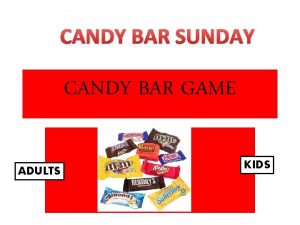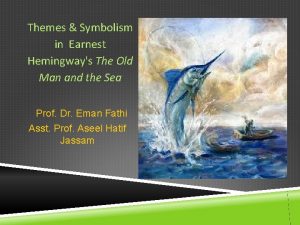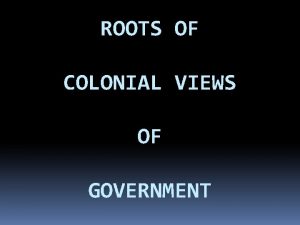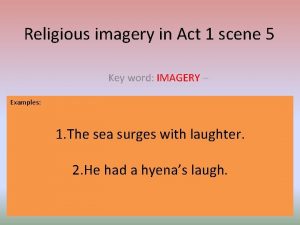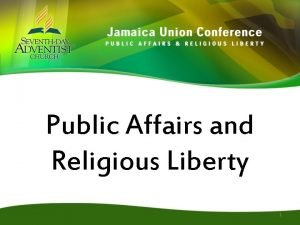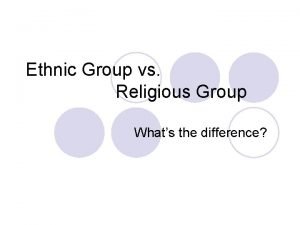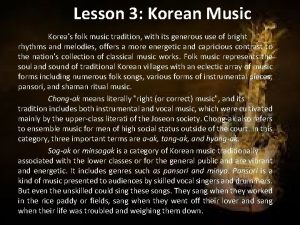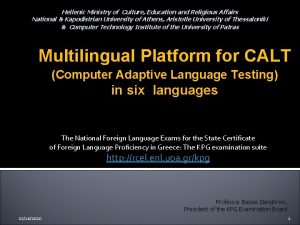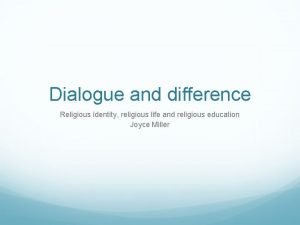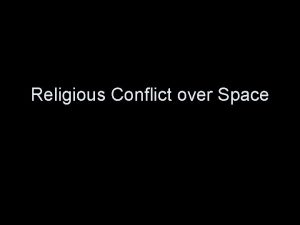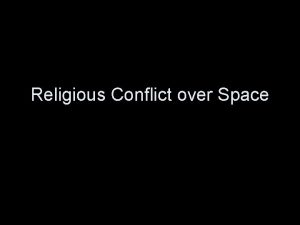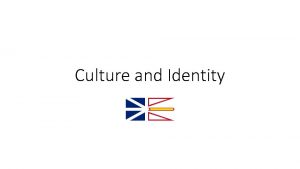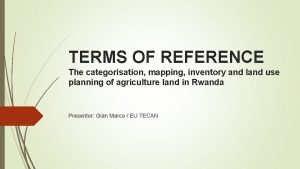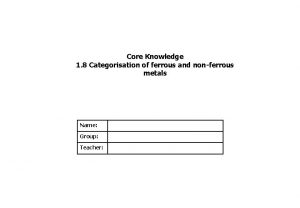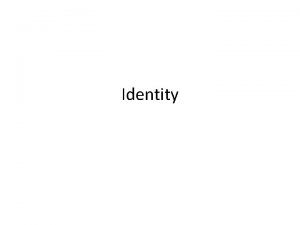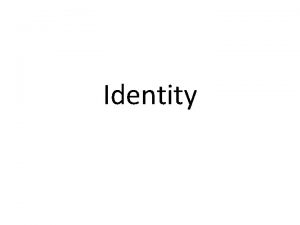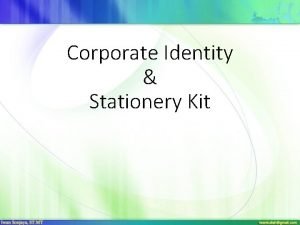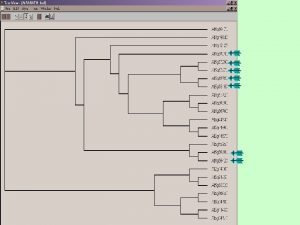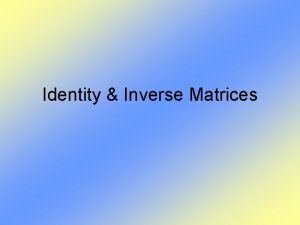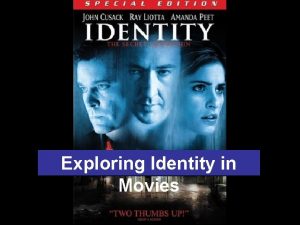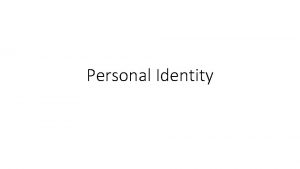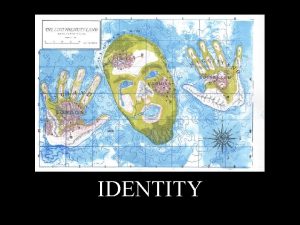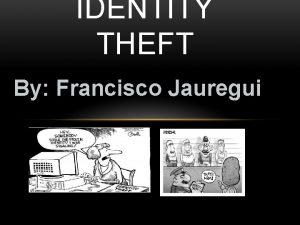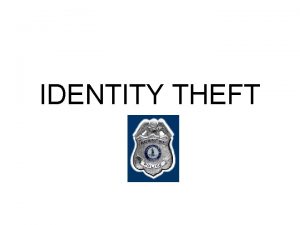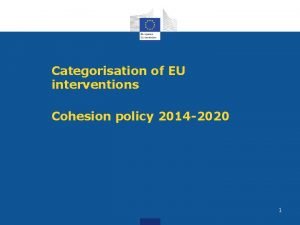RELIGIOUS IDENTITY AND CATEGORISATION OF THE OTHER A






![Identity and Categorisation NI DATA COLLECTION › A: Free-sorting [Coxon, 1999] N=46 (N* =44 Identity and Categorisation NI DATA COLLECTION › A: Free-sorting [Coxon, 1999] N=46 (N* =44](https://slidetodoc.com/presentation_image/a37a1238eef26d23f879cf359069c99b/image-7.jpg)

![9 MDSORT 2 D Config [VRe. HRe] MINISSA of Co-occ 2 D Identity and 9 MDSORT 2 D Config [VRe. HRe] MINISSA of Co-occ 2 D Identity and](https://slidetodoc.com/presentation_image/a37a1238eef26d23f879cf359069c99b/image-9.jpg)














- Slides: 23

RELIGIOUS IDENTITY AND CATEGORISATION OF THE OTHER: A sorting study of Northern Irish Identities Tony Coxon (Universities of Cardiff & Edinburgh) Data from Dr Adrian Stringer, Moneymore, Co. Derry) _________________________ _ This talk (Identity and Categorisation-TCD. ppt ) is downloadable from www. methodofsorting. com 1

Identity and Categorisation NI � In the Province of Northern Ireland, Social identities are strongly overlapping: › Political (Unionist, Republicanism), › Social (Class, Organizations, Gender) and › Religious ([Roman] Catholic, Protestant (Cof I, other) Often thought of as a simple religious polarisation (e. g. religion as an ethnic marker), but actually a more complex pattern. � A recent study by Stringer investigated social networks and in/out group membership based on a range of religious denominations � › Using a heterogeneous set of identities, organizations and affiliations › And using a free-sorting task to allow relevant categories to emerge & their inter-relatiopns to be investigated. Coxon & Stringer 2010 2

Identity and Categorisation NI � The resulting sortings data also › illustrate extreme forms of categorisation › But still show significant differences. � By including questions on "See yourself as” for the Identities, it revealed relevance of the concept of reference groups to the explanatory account. › The use (and some shortcomings) of the method of free-sorting (Coxon 1999)are well illustrated by these data and their analysis. Coxon & Stringer 2010 3

Identity and Categorisation NI 2: LOCATION, CONGREGATIONS & SUBJECTS ANONYMITY: Real locations, Modified Congregation names, Subject nos. › LOCATION: Province of Northern Ireland › CONGREGATIONS: › [Code] › M › J [Denom. ] Church of Ireland (Anglican) Roman Catholic [Name] St Matthias St John & St Trea › C Independent Evangelical Christchurch › B Baha’i › (n. b. Presbyterian refusal: local Minister of the Presbyterian Church of Ireland, the largest local congregation, refused to collaborate, insisting that his Church members would be unwilling to co-operate. › SUBJECTS: Between 10 & 12 congregants selected by gatekeepers. (see notes). Identified by number and congregational code. Coxon & Stringer 2010 4 N= 46:

Identity and Categorisation NI “Objects” (Identification Groups/labels) Conventionally, objects refer to a single domain (or disjoint domains). These 27 cover a range of domains: › Domains: Nationality-- Political-- Denomination Specific -- Denom/ Faith General— Gender-- Religious Marked Affiliation -- Class -- Intimacy Marker (1) See following ……………. Coxon & Stringer 2010 5

DOMAINS Ethnic / Political Nationality Party CARD NAMES 1. Irish 2. Scottish 3. Irish Scots 4. Ulster person 5. Unionist 6. British 7. Republican 8. Middle Eastern 9. Northern Irish 10. Christchurch Independ. 11. Baha'i Community of NI 12. Ballyeglish Cof. I 13. St John & St Trea RC 14. Baha'i *15. Christian 16. Protestant 17. Roman Catholic 18. Church of Ireland *19. Male *20. Female 21. Hibernians Supp. 22. Orange Lodge Supp. *23. Upper Working Class *24. Lower Middle Class *25. Working Class *26. Middle Class *27. Belonging to my Family Denominl. Faith Congregati Group on Gender Partisan Social Class Family Voluntary marker Group 1 1 1 1 1 1 1 Coxon & Stringer 2010 6
![Identity and Categorisation NI DATA COLLECTION A Freesorting Coxon 1999 N46 N 44 Identity and Categorisation NI DATA COLLECTION › A: Free-sorting [Coxon, 1999] N=46 (N* =44](https://slidetodoc.com/presentation_image/a37a1238eef26d23f879cf359069c99b/image-7.jpg)
Identity and Categorisation NI DATA COLLECTION › A: Free-sorting [Coxon, 1999] N=46 (N* =44 with 2 exclusions see below) p = 27 (FULL); = 19 (REDUCED) (See Data in accompanying Table 1) No constraint on # of groups Sorting Characteristics: DEN. Baha’i C (Ind. Ev) J (RC) M (Cof. I) TOTAL RANGE 1 – 14 1 – 23 2 – 15 1 – 23 (13) (22) (11) (13) (22) #LUMPERS 1 1 0 0 2 › B: Belonging and Ordering Identities AVE # GPS 5. 2 10. 5 6. 4 6. 5 7. 2 : how they see/identify themselves: [do/ don’t /uncertain about] Then rank items in their positive identification pile. This enabled some indication about what identification/s were most important and the place of religion within their identities. Coxon & Stringer 2010 7

Identity and Categorisation NI DATA ANALYSIS (D-T-M). › Data: N=44 (2 lumpers removed), p= 27(full), =19 (reduced) Sorting data in “preferred data format” (see Table 1 et ff) [X(i, j) gives the “own category” number (pile) into which subject i places object j ], e. g. B 1 7 7 7 5 6 1 6 7 7 4 1 4 4 1 3 3 1 5 2 2 8 8 1 (8 piles; no singletons) › Transformation: Usually ordinal -> linear (also spline) › Model/s: Euclidean Distance (for 2 D maps – context); for framework Clustering (for categorization): “Branch&Bound” Partition & Hierarchical Clustering for levels › Programs: The Sorting data were analyzed: using SORTPAC www. methodofsorting. com/coxon. htm To produce [weighted] co-occurrence matrices and dis/similarity measure/s for scaling using programs within New. MDSX package http: //www. newmdsx. com/ , including: MINI-SSA, HICLUS, BBDIAM [2 W 1 M] and MDSORT [2 W 2 M, Takane 1981] Coxon & Stringer 2010 8
![9 MDSORT 2 D Config VRe HRe MINISSA of Coocc 2 D Identity and 9 MDSORT 2 D Config [VRe. HRe] MINISSA of Co-occ 2 D Identity and](https://slidetodoc.com/presentation_image/a37a1238eef26d23f879cf359069c99b/image-9.jpg)
9 MDSORT 2 D Config [VRe. HRe] MINISSA of Co-occ 2 D Identity and Categorisation NI

Identity and Categorisation NI Categorization & Clustering › Two variants used: Partition Clustering (divides data-objects into a single set of n [user-specified] exclusive and exhaustive clusters , based on a dis/similarity measure). Often Mac. Queen’s k-means clustering is used, here Brusco 2003’s branch&bound diameter method (BBDIAM) by preference for producing best SINGLE partition (set of categories) Hierarchical Clustering (Johnson 1967) provides set of levels from “splitter” to “lumper” partitions such that each level includes clusters present at lower (finer) levels. If solution is perfect data exhibit ultrametric inequality; otherwise two (maximum and minimum )solutions demark the two extreme possibilities. Used here for inferring higher-level bases of categories. … and also Overlapping/additive Clustering (Arabie & Carroll 1980) – a very desirable form of analysis, but the program is not available! Coxon & Stringer 2010 10

BBDIAM Partition Solution: FULL Co-occurrence; 5 Group solution CLUSTER 1) National Identities 2. SCOTTISH, 3. IRISH SCOTS, 6. BRITISH, 8. MIDDLE EASTERN, 9. NORTHERN IRISH CLUSTER 2) (Ulster) Protestant 4. ULSTER PERSON, 5. UNIONIST, 10. CHRISTCHURCH IND, 12. BALLYEGLISH COFI, 15. CHRISTIAN, 16. PROTESTANT, 18. CHURCH OF IRELAND, 22. ORANGE LODGE SUPP. CLUSTER 3) (Irish) Roman Catholic 1. IRISH, 7. REPUBLICAN, 13. ST JOHN & ST TREA RC, 17. ROMAN CATHOLIC, 21. HIBERNIANS SUPP. CLUSTER 4) Baha’i 11. BAHA'I COMMUNITY OF NI, 14. BAHA'I, 20. FEMALE, 27. BELONGING TO MY FAMILY CLUSTER 5) Class 19. MALE, 23. UPPER WORKING CLASS, 24. LOWER MIDDLE CLASS, 25. WORKING CLASS, 26. MIDDLE CLASS Coxon & Stringer 2010 11

HICLUS SOLUTION FULL Co-occurrence data; Connectedness Method Coxon & Stringer 2010 12

HCS-Conn. Clustering / 2 Coxon & Stringer 2010 13

FULL INTERPRETATION! Co-occurrence Data, SSA 2 D solution, interpreted with BBDIAM clusters and HCS cores/exemplars, and re-locations 14

Identity and Categorisation NI It becomes obvious that › it is the four congregational/affil. groups that are the primary meaningful units and they each have different (often contradictory) patterns of identity. So, analyze WITHIN each of the 4 religious groups › Objects like the class titles and gender titles were not treated in the same way as the other objects (though they were often used as illustrations of "that group” A lot of people simply put the four class terminology cards in a separate pile, and many did the same with male/female cards So, remove Class and Gender Identities them from subsequent analysis The card “ 27. belonging to my family" was typically used as a marker of "our" identity. Each group located it firmly in the centre of their own key identity/groups. So, remove it also from subsequent analysis Although “Christian” was in some cases appropriated to their own primary group, usually it was used generically, or as a singleton So, remove it also from subsequent analysis (for scaling at any rate!) The resulting 27 -8 = 19 objects are now retained (“REDUCED set” – see Slide 6) The “SEE YOURSELF/DON’T SEE YOURSELF “ data (table 2) and subsequent ranking of their own identity are also used to clarify matters. Coxon & Stringer 2010 15

Identity and Categorisation NI Patterns of Identity and “Negative Identity” › The “See-as” data provide useful evidence of different points of view of identity, viewed from each denominational perspective › Quite remarkably, there is (IMHO) a staggering degree of unanimity or consensus within the four groups: not only on “who I am/we are”, but also of “who I/we are NOT”. In effect, these are positive and negative Reference Groups, in Merton’s terminology. › Typically, each Congregational group identifies one or two tight positive ref. gp cluster (the "us") and then (usually) between 2 and 4 out -groups that act as their negative reference. › First, a general overview of the patterns of consensus, and then each group in turn with its pattern and its scaled configuration (from MDSORT) Coxon & Stringer 2010 16

Identity and Categorisation NI Basic Data are : (Table 2): Set of the 27 identity items sorted in terms of: › ”See myself as belonging to X…” into 3 fixed response categories : Agree/Disagree/Unsure. (Table 3): Subject s then were asked to rank their “agree group” items › Because Ss differ in size of Agree group/pile they form, restricted for analysis to their top five in terms of ordering, to keep comparability. Research Questions: › (1) How far are members agreed within their community in terms of POSITIVE identification ? In some cases there was (almost, or total ) unanimity of agreement (coded yellow ). The entries are their rank letter. › (1) How far are members agreed within their community in terms of NEGATIVE identification ? Here there are typically 9 or 10 objects which are unanimously (or almost) rejected for identification (coded purple) in each community – a significant fact! Further analysis can take two forms: What pattern of Pos/Neg identification characterise each community (and whether they are reciprocated!) For each item/object, which communities claim or disavow them. Coxon & Stringer 2010 17

PATTERNS OF CONSENSUS: 4 DENOMS ITEMS (top cols): 1. Irish 2. Scottish 3. Irish Scots 4. Ulster person 5. Unionist 6. British 7. Republican 8. Middle Eastern 9. Northern Irish 10. Christchurch Ind Ev. 11. Baha'i Commty. of NI 12. Ballyeglish Cof. I 13. St John & St Trea RC 14. Baha'i 15. Christian 16. Protestant 17. Roman Catholic 18. Church of Ireland 21. Hibernians Supp. 22. Orange Lodge Supp. BLOCKS: B: BAHA’I C: EV. INDEP J: RC M: Cof. I 18

MDSORT BAHA’I IDENTIFICATION 1 B 2 B 3 B 4 B 5 B 6 B 7 B 8 B 9 B 10 2 3 4 5 7 8 e d e d B 11 e B 12 B 13 6 e 9 10 11 12 13 14 15 16 17 18 21 22 0 0 0 0 0 c c c c b b e x x x x x 0 0 0 0 0 b a a a a 0 0 0 0 0 0 0 0 0 0 0 0 0 b x 0 a 0 0 0 a x 0 b 0 0 0 b x 0 a 0 0 0 d b 19

20 identification MDSORT CHRISTCHURCH INDEP. EVANGELICAL

21 Identification MDSORT Roman Catholic

22 Identification MDSORT Church of Ireland (Anglican)

Identity and Categorisation NI So what? Some Conclusions & Results Similarity, difference and belonging are central concepts to this account. Despite common perception, bipolarisation is (grossly) inadequate representation • several groups and bases & contexts for judgment; • mediation via 3 rd groups, and (multiple) positive & negative • belonging is better seen as evaluation on perceived similarities… But nonetheless: • Shared perspectives within religious communities, with unusual “tight” in-groups and distant out-groups • high consensus not only about boundaries but also evaluations of out-groups • Only partial symmetry/reciprocity between groups. Almost all of these issues can in principle be approached and tackled within this methodological framework. Coxon & Stringer 2010 23
 Personal identity identity map
Personal identity identity map Bite with crackling noise candy bar
Bite with crackling noise candy bar The candy bar game
The candy bar game Self initiated other repair
Self initiated other repair Religious symbolism in the old man and the sea
Religious symbolism in the old man and the sea Religious and classical roots description
Religious and classical roots description Cognitive and non cognitive religious language
Cognitive and non cognitive religious language If i profane with my unworthiest hand
If i profane with my unworthiest hand Public affairs and religious liberty
Public affairs and religious liberty What's the difference between ethnic and religious group
What's the difference between ethnic and religious group Used in both the folk and classical court music of korea
Used in both the folk and classical court music of korea How are ethnic groups and religious groups related
How are ethnic groups and religious groups related Hellenic ministry of education and religious affairs
Hellenic ministry of education and religious affairs Greek and roman art similarities
Greek and roman art similarities Hình ảnh bộ gõ cơ thể búng tay
Hình ảnh bộ gõ cơ thể búng tay Ng-html
Ng-html Bổ thể
Bổ thể Tỉ lệ cơ thể trẻ em
Tỉ lệ cơ thể trẻ em Voi kéo gỗ như thế nào
Voi kéo gỗ như thế nào Thang điểm glasgow
Thang điểm glasgow Hát lên người ơi alleluia
Hát lên người ơi alleluia Kể tên các môn thể thao
Kể tên các môn thể thao Thế nào là hệ số cao nhất
Thế nào là hệ số cao nhất Các châu lục và đại dương trên thế giới
Các châu lục và đại dương trên thế giới


